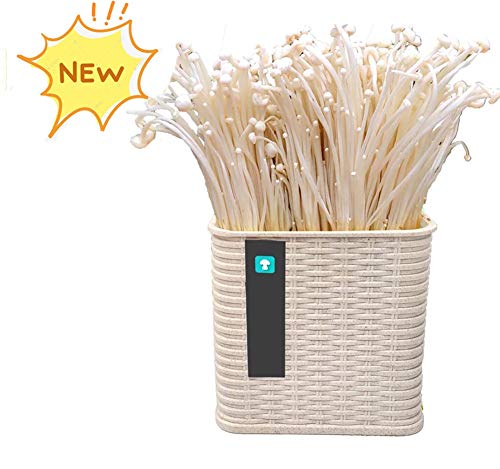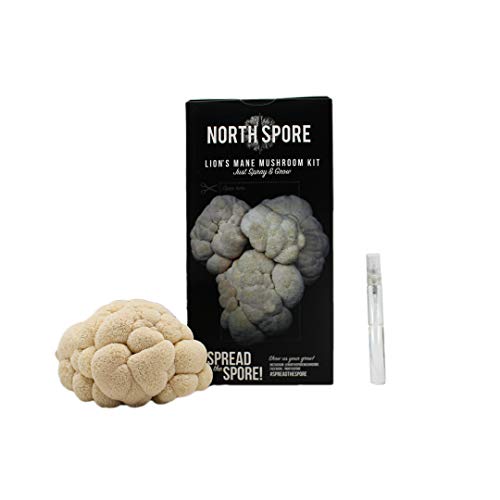Do you enjoy gardening? Have you ever thought of adding mushrooms to your list of decorative indoor plants? You’re in good company. Many of our readers have been asking: “Can I grow mushrooms as a house plant for decoration?”
Yes, you can grow mushrooms as houseplants. Mushrooms can make an attractive addition to your indoor gardening collection. One reason is that they have such cute features. They’re also low-maintenance and easy to care for.
If you’re interested in finding out more about growing mushrooms as indoor plants just like us, read on.
Note: If you click some of the links or pictures in this article we may earn a small commission at no additional cost to you.
Can I Grow Mushrooms as Houseplants?
Yet, it’s important to remember that growing mushrooms isn’t like growing other types of plants. They’re made up of slender fibers that grow in the soil, sometimes even on top of it.
These fibers can appear delicate and frail. However, they form such an intricate network that’s actually quite resilient and enduring.
Yet, they remain out of view for most of their life. They’re so good at hiding that you wouldn’t even know they were there until they begin to fruit mushrooms.
How to Grow Mushrooms as Houseplants
We’ll use the video below to quickly walk you through growing mushrooms as houseplants.
For this example, we’ll use the terrarium method (it’s one of the more beautiful ways to do it – see our full article on this topic which includes places to get the necessary gear and kits).
The video below assumes you want to make a terrarium solely for mushrooms. Yes, you can do this and it looks great.
But what if you want to add mushrooms to an existing terrarium? To do that we’ll need to adjust the directions below slightly.
This works great for some of the colorful oyster kits we discussed above.
- Acquire a block of mushroom spawn. Click on one of the pictures in this article or simply google the mushroom grow kit then find the type of mushroom you’d like to grow.
-

We recommend a colorful oyster mushroom kit like the one above. Click the image to check the current price on Amazon. 

-

We recommend this lion’s mane kit to add a little texture. Sadly it only comes in white (for now!). Again, click the image to purchase this kit on Amazon. I’ve used it and it works great though it’s much slower than the oyster kits. Use that to your advantage. This kit will last longer as a decoration since it takes longer till it reaches peak fruit.
-
- Cut a small square of the block.
- Wrap the remaining block in plastic and store it in the dark. You’ll end up using a new piece each time you want to grow a new set of mushrooms.
- Wrap it in tin foil leaving the top open.
- Check the directions of your kit. Some will have you soak the block in water for 6 hours. Others will simply require you to water it. If it needs soaking then do this now. The tin foil will help keep it together while soaking.
- Place it into the existing terrarium soil with the open part of the foil face up. This is the area the mushrooms will grow out of.
- Cover with moss or something decorative to help hold in the moisture but not too dense that it still doesn’t get a little light.
- Water daily with a spray mister 1-2 times a day.
- In 7-21 days mushrooms will emerge and grow to full size.
- When they die back you can start over with a new piece from your mushroom block.
Types of Mushrooms as Houseplants
Below you’ll find a few easy examples of mushroom kits you can buy that can be grown as houseplants.
All pictures lead to kits you can buy on Amazon. Just click the images to see the current price.


Mushrooms vs Houseplants
As you can see in the example above, growing mushrooms indoors for decoration is different than caring for houseplants. They really only shine when they are fruiting. Most of the time they’ll be growing underground until you change the conditions to make them fruit again. That’s why we recommend the terrarium option so you have other beautiful things to look at while you wait.
That being said, it’s important to know the basics about mushrooms if you want to use them in place of houseplants.
Are Mushrooms Plants?
Given the fact that they have no chloroplasts and lack the genetic material needed to encode enzymes for making their own food, mushrooms are not plants.
Mushrooms are heterotrophic organisms; meaning they can’t break down carbohydrates on their own and have to rely on other sources of sugar. They lack any photosynthetic pigments or chlorophyll which is found in both plants and animals, and there aren’t any genes specific for producing such biochemical substances either. By definition then, mushrooms do not function as a plant does because they do not create sugars from sunlight like plants but rather receive all nutrients from another source completely unrelated to light or water.
What Are Mushrooms?
The mushroom may seem to be a simple organism to our untrained eye. After all, it’s just a cute little plant, right? Wrong.
Mushrooms are quite different from plants. In fact, they belong to the Kingdom Fungi, which is separate from that of plants.
One difference is that mushrooms are cultivated from spores. They don’t need seeds to grow.
They also don’t rely on light to make their food. This is one reason why mushrooms can grow in dim, even dark, places.
Parts of a Mushroom
Mushrooms are made up of three main parts that work together in perfect harmony. Read on to learn about the complex network that makes up these fungi.
Mycelium
The main part of a mushroom is under the ground in the form of mycelium. These threadlike filaments can be hidden in the soil, on decaying logs, or any other food source.
Mycelium can be as small as a small insect, or large enough to cover several acres. Not only that, but they can grow quickly. The mycelia branches can add more than half a mile of additional fibers daily.
Hyphae
Hyphae are the tiny branches that make up the entire network of mycelium. Each hypha may be small in size, yet it has numerous jobs to do.
Hyphae work together to absorb nutrients from their surrounding environment and can carry them across great distances. They’re the main source of water and nutrients to the rest of the plant, mainly the thallus, or the fungus body.
Thallus
The thallus is the visible part of the mushroom cap. It’s this top part that’s similar to the fruit of a tree. A fully-grown thallus can contain up to 16 billion spores.
Thalli can come in various sizes, shoes, and colors. They take about two weeks to fruit before they’ll start to decay.
How Mushrooms Make Their Food
The main difference between the two is in the way each type of organism obtains its food. Plants contain chlorophyll, which helps them make their own food through a process known as photosynthesis.
Fungi mushrooms, on the other hand, don’t contain any chlorophyll. They get their nutrients by breaking down nonliving organic matter.
These nutrients, along with important essential compounds, are stored in the mycelium. When the amount of nutrients is enough, mushroom fruit will start to appear.
Mushrooms need water to grow. In fact, a mushroom can go from being the size of an ant to being the size of a hefty mushroom in the course of a few hours.
They don’t do this through cell division, unlike plants and animals. They do this through a process called ‘cell enlargement.’
Fun fact: mushrooms have the same number of cells from the beginning of their life cycles all the way to the end.
How to Tell if a Mushroom Is Poisonous
Mushrooms may seem innocent enough. Yet, despite their harmless demeanor, some can be quite poisonous.
Experts recommended that you don’t grow these indoors because of their profound impact on your health. Some of these include vomiting, convulsions, diarrhea, and kidney failure.
One way to tell if a mushroom is poisonous is by smelling it. They usually give off a noxious, pungent smell that can be irritating.
Here are a few other signs to help you identify poisonous mushrooms.
- Mushrooms in the shape of umbrellas
- Scales, warts, raised patches, or spots on the mushroom cap
- White rings around the stem
- Bulbous sacs near the base of the mushroom
- Thin, white gills
- White spore prints
Related Questions
Here are a few questions and answers to help shed light on growing your own mushrooms.
Q: What are some popular mushroom choices to grow indoors?
A: There are more than 14,000 mushroom types. Out of these, several types make great houseplants. A few examples include:
- Shitake
- Oyster
- Cremini
- White Button
- Maitake
Q: How much water do mushrooms need to grow?
A: Mushrooms are made up of 90% water. This makes them quite hungry for water.
You should water mushrooms at least twice a day. You should also mist the gills several times a day.
The way you apply water is just as important. Too much water at once can kill the mushrooms. Plus, it can lead to mold and bacterial growth, which isn’t healthy for the mushrooms.
Q: When’s the best time to harvest mushrooms?
A: You can grow mushrooms year-round. Yet, the best time to harvest them is when the first ‘flush’ appears.
A flush is a group of blooming mushroom caps. The appearance of these flushes signals the harvesting period for mushrooms.
Hi, I’m John Stephens, chief editor and writer for Totalgardener.com. I’ve been gardening and raising animals for over 15 years starting with a small backyard plot in Northern Virginia where I grew corn, potatoes, squash, and using a high mulch technique called the Ruth Stout Method. I also raised ducks and small mammals for meat and eggs in a movable pen similar to the ones used by Joel Salatin. I later moved to Colorado where I experimented with growing greens using aquaponics inside. I eventually added a microgreens setup and home sprouting operation. I’m excited to share everything I’ve learned plus more from the other local gardening and animal raising experts I know.







